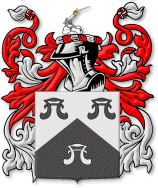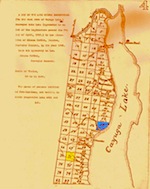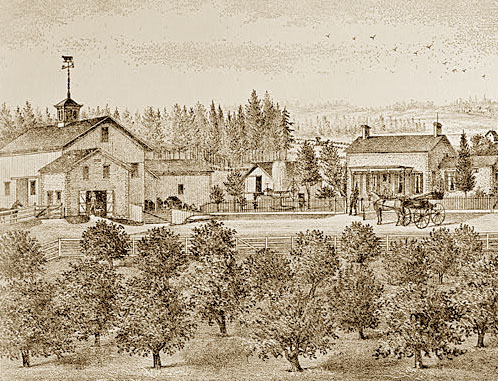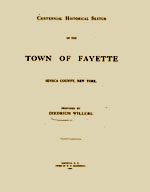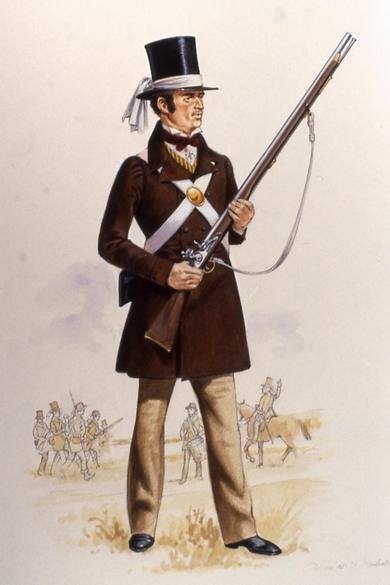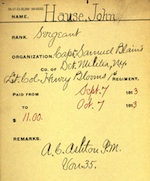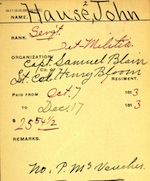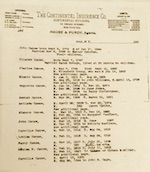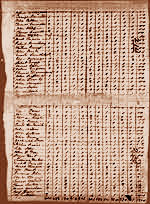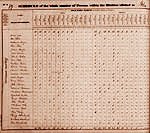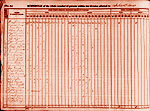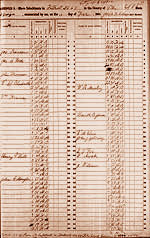 |
"He was born of Dutch parents in the town of Warwick, Orange Co. New York... In 1802 his parents removed to the 'lake country' and purchased a small place called Ovid Center... two weeks on the way in a covered wagon, as was then usual drawn by a yoke of oxen... In 1805 or 1809 his father sold this purchase to his brother ... and bought out the improvements of a squatter on a two hundred and fifty acre lot which from him has ever since been called Hause's Point."
—The early trials of the John Hause family, as recounted by his son, Charles, to a newspaper reporter in 1885.
|
On 6 Nov 1796, John married 17 year-old ESTHER KETCHUM (9/5/1779 - 9/21/1853), the niece of fellow Old School Baptist Church member Philip Ketcham, and the daughter of LT. NATHANIEL KETCHAM, a carpenter in Warwick and a hero in the Revolutionary War (here's his account of the war). So while William and Nathaniel exchanged war stories at Baird's Tavern in Warwick, and talked of the past, their children John and Esther planned a future, and a move west to newly-opened areas of New York, where the Seneca Indians (who had fought with the British) were being removed.
"... Two weeks on the way in a covered wagon, as was then usual drawn by a yoke of oxen."
—Profile of Charles Hause, 1885
|
|||||||||||||||||||||||||||||||||
The area where the family headed was organized in 1800, after being purchased from the Cayuga and Seneca Indians of the Iroquois Confederation of Nations in 1789. (In other words, the U.S. took their land in retaliation for helping the British Army during the Revolutionary War.) This newly available land was abundant, and as John acquired unsettled territory (such as the property that is today 4405 Route 89, Ovid, New York), he would leave his family to work the land, while he continued onward in order to stake more claims. As the land was improved and more people moved in around him, the property's value increased and John prospered. One location is revealed by an act passed by the state's legislature in 1801, for "improving the state road from the house of John House of Utica to the village of Cayuga, and from thence to Canadarque, Ontario County."¹ By 1806, John had wheeled and dealed and flipped enough property to acquire a beautiful estate on the western shores of Cayuga lake, double the size of the average area farm, which from that time on was called "Hause Point." John's real estate and agricultural businesses prospered, as did his family. He was living the American Dream.
CHANGE OF NEW YORK ADDRESS |
At first glance when reading census records, it seems like the Hause family was moving all over the place during the 19th Century, but a history of the counties in New York reveals that the names of their residences were changing as much as their actual homes, as county boundaries changed practically every decade:
|
"Very few advantages were offered his youth, but few schools, no churches and their nearest mill was at Waterloo. The wild unbroken forest was spread out all around them with here and there only a settler. The timid gentle deer fed with their herds on their fields of grain till he had reached his early youth."
—Profile of Charles Hause, 1885
|
Americans were a hardworking agricultural people, and there was little time for play, although on June 16, 1806, there was a total eclipse of the sun across the northern United States, and for a few hours, all work ceased as the country was covered in darkness. "The people stood in silent amazement," wrote a Reverend in Massachusetts. But a lot of Americans weren't standing, it turns out, because nine months later there was a marked increase in the number of births (the same reverend counted four births in just one neighborhood that he visited). John and Esther didn't participate in this mini-population explosion, but they didn't need to, since they already had five children, and would add seven more in the next dozen years:
CHILDREN OF JOHN HAUSE AND ESTHER KETCHAM |
|
|
|
|
|
|
|
|
|
|
|
|
|
|
|
|
|
|
|
|
|
|
|
The town where they lived was called Washington until 1808 (John is registered on an 1804 jury list), when it was changed to honor French General Gilbert Motier de LaFayette. Fayette was situated between two beautiful lakes, with the northern boundary formed by a river. This made the soil rich and ideal for planting, and the winter climate and temperature was favorably softened by the proximity of the lakes. The water in those lakes was filled with salmon, the woods were full of bear and deer, and the brush was abundant with strawberries, gooseberries and mulberries. Outside of the occasional Indian attack, it was truly a paradise. John officially purchased land there in 1812, even though his son Alanson was born there in 1810. It was a "military farm lot," but whether it was acquired through the Revolutionary War service of John's father, William, or Esther's father, or through his own military service is unknown.
John's property, a Military Lot located nearby on the edge of the Cayuga Reservation, was ceded to him on December 28, 1812. It was renamed Hause's (or Hauze's) Point, and a creek running onto the property was named after him as well.
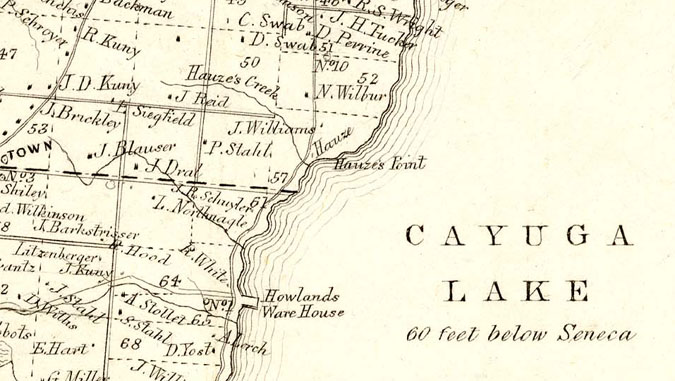 John Hause's lakefront land on Hauze's Point and Hauze's Creek (sic), near Fayette in Seneca County. (Click here to see the entire map of Seneca County.) |
|
Assembling an army proved to be difficult. The militia system had decayed since the Revolutionary War, and the Constitution had divided authority over the militia between the state and national governments. Americans' traditional fear of a standing army, and possible military overthrow, resulted in the young republic depending too heavily upon untrained militia, rather than regulars. So there was a lack of trained fighters and commanders. Furthermore, they could not to be compelled to serve a longer time than six months, so by the time they learned how to fight, they would leave. Then more soldiers died from disease than from fighting.
How many in the Hause/House/Hawes family actually fought during this war is impossible to say. Muster roll calls are hard to find, but here's a list of claim awards from the Veterans of New York:²
| NUMBER | NAME | RESIDENCE | AMOUNT |
| 5,437 | Hause, George | Cameron, Steuben Co., NY | $53.00 |
| 2,607 | Hause, John | Seneca Co., NY | $11.00 |
| 2,611 | Hause, John | Seneca Co., NY | $25.54½ |
| 1,253 | Hause, William | Niagara Frontier, NY | $25.03 |
| 1,198 | Hauser, William | Manlius, Onondaga Co., NY | $68.00 |
| 4,374 | Hawes, David Jr. | Beekmantown, N.Y. | $20.50 |
| 15,143 | Haws, Morris F. | Walworth County, Wisconsin | $25.00 |
| 8,308 | Hawse, Abraham | Granby, New York | $18.25 |
When war was finally declared, New York supplied 77,896 men to the war effort—providing their own arms and clothing. Back in Yates County, Hause Hill became a military training base under the leadership of Captain John Sebring, a revolutionary war hero.³ Meanwhile, John Hause served as a sergeant in Lt. Col. Henry Bloom's 1st Regiment of Det. Militia, Seneca County, New York, and in Capt. Samuel Blain's company. John's payroll cards from 7 Sep 1813 to 17 Dec 1813 are in the state archives. It would've been hard not to fight in the war, since skirmishes were fought right up the street from his house.
|
|||||||||||||||||||||||||||||||||||||||||||||||||||||||||||||||
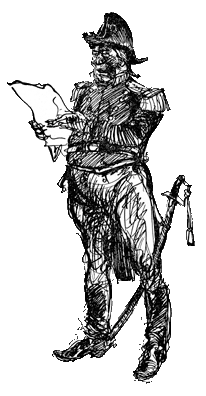 |
The war climaxed at the Battle of Lundy's Lane, the bloodiest ever fought on Canadian soil, near Niagara Falls, Ontario, in 1814. In a vicious six hour fight in the heat and darkness, a British force amounting to nearly five thousand men fought an American force of about two-thirds that number. The losses were severe: Eight hundred and seventy-eight men on the British and eight hundred and fifty-one on the American side. Most of the dead soldiers were burned on the battlefield in a gigantic funeral pyre. What happened to John would end soldiery as a career choice in this line of the family...
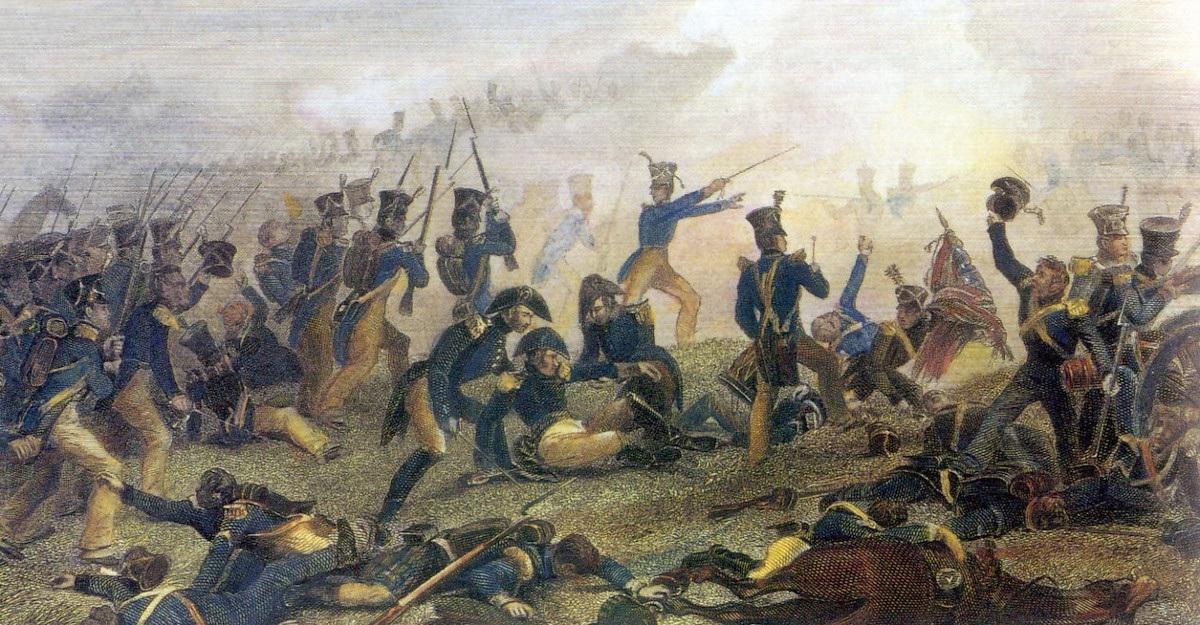 The U.S. infantry attacks at Lundy's Lane. Painting by Alonzo Chappel in 1859. |
"At least two veterans of the War of 1812 are buried in the Canoga Cemetery... John Hause... was taken prisoner at the Battle of Lundy's Lane."
—"WAY BACK WHEN IN SENECA COUNTY," by Walt Gable, Jan 11, 2015
The United States forces retreated the next day to Fort Erie, but the New York Cavalry left without a sergeant. John Hause was captured by enemy forces and imprisoned.⁴ One can only imagine how his children back in the United States—such as ten-year-old son Augustus—feared for their father, and even wondered if they would ever see him again. Enlisted men were generally kept confined in conditions that were not healthy. Officers and enlisted men could be exchanged for an equal number of the same rank amongst enemy prisoners. After a time he was finally released, and the War of 1812 and hostilities between Great Britain and the United States finally, mercifully ended. John came home, unsaddled his horse, put his rifle away, and he and his brothers in the Hause/Hawes family reverted back to their simple lives as farmers, carpenters, yeomen and bad spellers.
More than four out of every five Americans during the early 19th century still lived on farms. Many farmers during this time also made goods by hand that they'd use, barter, or sell, such as barrels, furniture, or horseshoes. John Hause was an industrious man. The average farm was less than a hundred acres in size, but John's had grown to two and a half times that large. But only about sixty acres were probably used for farming. The rest of the property would have been covered in large trees, which John needed to build tools, furniture, his barn and his cabin, made from bark-covered logs. His fields were planted with oats, flax, potatoes, hay, corn and wheat. Apple, peach, pear and plum trees were planted in clearings on the hillsides. In spring, he and his sons used teams of oxen to pull a wooden plow across the rocky New York soil. The blade of the plow was coated with sheet iron or old saw blades, and tipped with brittle iron. If it broke (which was often), then the plowing was concluded for the day. Grain was sowed by "broadcasting"—throwing the seeds over a wide area by hand. Weeds were pulled by hand or chopped with a hoe, and the finished product was cut with a scythe. Their diet was augmented with his musket, hunting squirrels, rabbits, wild turkeys, ducks and other game. In fact, the people on the farms of America were the best-fed people in the world at that time. (Sadly it would add up to a lot of extinct or endangered animal species. At the time the supply seemed unlimited.)

|
There is an old saying that the bones of Yankees were made of Indian corn. This was because corn was the staple product of the farm. It was eaten green in summers, but usually it was left to ripen in order to make cornmeal and hominy. It also fed the animals, and was processed into meal by the local miller. The cobs were used to plug jugs and fuel fires.
At harvest time, John and his sons would cut the corn with long knives and "shock up" the stalks to dry for a few weeks before hauling them into the barn, where the ears waited to be husked in colder weather. Threshers wouldn't be invented for years yet, so their neighbors would turn out and help with the husking, as was the tradition in Early American farms. In fact, it was handled more as a party. A girl at a husking bee got kissed each time her beaux found a red-kerneled ear. Neighborhood huskings occurred until every farm in the neighborhood had cleared its barns, around Christmas. Then Esther and the women would set out a large meal for everyone.
The fruit in the orchard was dried, or cooked with sugar to make preserves and jelly, for use in the winter. It was also used for cider, which John distilled into Applejack (apple brandy). He also made peach brandy, plum brandy, and rye whisky. A gallon jug was available to the men at every husking. It was also bartered as money.
The flax stalks were beaten to pull the long linen fibers out of them, which Esther would spin into yarn to make clothes. In the spring, John and his sons would fleece the sheep for wool. Esther then made clothing for the family, as well as their bedding, on a large loom.
Other clues to John's and Esther's lives on the farm are revealed in this 1885 newspaper profile of their son, Charles:⁵
| By chance last week we passed a night with the aged pioneer Mr Charles Hause on Hause's Point on the west shore of Cayuga Lake. In the morning we learned it was Mr Hause's birthday (86th) and that he had spent eighty of these years on the same point of land. He was born of Dutch parents in the town of Warwick, Orange Co. N.Y. March 3, 1799, a babe in his mother's arms when the "Father of his Country Died". In 1802 his parents removed to the "lake country" and purchased a small place called Ovid Center, the same farm lately owned by Geo Helfuean, son-in-law of your townsman A. Flickinger, Esq. In 1805 or 1809 his father sold this purchase to his brother ... and bought out the improvements of a squatter on a two hundred and fifty acre lot which from him has ever since been called Hause's Point. Here Charles' first distinct memory of practical life begins, although he now recalls several incidents of their carving into the wilderness; two weeks on the way in a covered wagon, as was then usual drawn by a yoke of oxen. Very few advantages were offered his youth, but few schools, no churches and their nearest mill was at Waterloo. The wild unbroken forest was spread out all around them with here and there only a settler. The timid gentle deer fed with their herds on their fields of grain till he had reached his early youth. When he had reached his majority he bought thirty acres of the rear part of his father's purchase and began life for himself. In 1826 he married Miss Elizabeth Young, and together they toiled adding to his little lot which with a portion set off to him from his father's estate now makes his farm one hundred and four acres of excellent grain land. Five children blessed their union, two sons and three daughters. One of these sons he gave to his country and he fell in the war for the Union at Cold Harbor, Va., and now lies in an unknown and unnamed grave. His wife, the faithful sharer of his struggles and triumphs, died in 1865 and two of the three daughters since then. He married a second time but was a second time bereaved and now, like a lone forest tree, almost branchless and leafless, blasted by many storms and winds of adversity, he waits his own removal. |
|
|||||||||||||||||||||||||||||||||||||||||||||||
By the time of this census, William Sr. was dead (he passed away in 1818), but John Hause (name finally spelled H-a-u-s-e) and his family (twelve strong) are now thriving in Fayette. In 1824, John bought back about a hundred acres he had sold from the north part of Lot 57 for one thousand and forty-two dollars, cash, so we know he was doing pretty well financially (page 1, 2).
The holy men in Fayette were prospering as much as the farmers, as the area was becoming the hotbed of religious controversy in the United States. In 1800, only about 10 percent of the nation's population had belonged to a church, but in the next two decades, religion made a comeback. Between 1825 and 1835 at least 1,343 "revivals" took place in the New York, helping to create a religious fervor of Protestant evangelism called the 'Second Great Awakening.'
Much of that new religious fervor took place in Central and Western New York, a deeply conservative area, where all of the farmers spent their hours either planting, parenting or praying. But after two wars with Breat Britain and the ups and downs of a newly created national economy, they were now open to new ideas that offered hope and certainty, and fit in with a new national identity.
Wave after wave of newly-created religions and theological ideas took fire in the area. Because of the intense belief that evil needed to be weeded out wherever it existed, many important reform movements such as abolition, women's rights, education reform, and peace advocacy, developed there. The Upstate New York area took on this name of "North Star Country," due to the antislavery activism. Fugitive slaves were said to be following the North Star as they headed north through the area to freedom. Also, a new religious idea called "deism" spread throughout the country. It followed the teachings of Jesus but denied his divinity. Benjamin Franklin, Thomas Jefferson, John Adams and George Washington were all deists. (The Unitarian Church is an outgrowth of this movement.) People also followed Jemima Wilkinson (the "Publik Universal Friend"), near Keuka Lake. There was also the Spiritualist movement started by the Fox sisters in Hydesville, and the Millerites who followed Baptist preacher William Miller's proclamations that, "Jesus Christ will come again to this earth, cleanse, purify, and take possession of the same, with all the saints, sometime between March 21, 1843 and March 21, 1844." (The movement predictably ended with the "Great Disappointment," but the die-hards formed the Seventh-day Adventist Church.) So many churches opened in the area that it became known as the "burned-over district," because it had been so heavily evangelized it had no "fuel" (unconverted) left to "burn" (convert). Still, the area's three largest denominations were the Methodists, Baptists and Presbyterians. Churches were numerous in the community, and most of them still spoke German. Esther Ketcham Hause came from an extremely Christian family and helped form the Second Baptist Church on March 20, 1819.
All of the rival religious factions were struggling to take hold in the burned-over-district, trying to out-shout each other while preaching to the already converted, but it really escalated when a new, controversial faith called "The Church of Jesus Christ of Latter-day Saints," or Mormonism, was created just down the road from the Hause farm, at the house of Peter Whitmer on Military Lot 13.
| From "History of Seneca Co., 1786-1876" [Ensign, Everts, Ensign, Philadelphia, 1876; reprinted by W.E. Morrison & Co., 1976] |
| "About the year 1820, Seneca Falls and Fayette were visited by an odd-looking boy, clad in tow frock and trowsers, and barefooted. He hailed from Palmyra, Wayne County, and made a living by seeking hidden springs. This boy was Joseph Smith, the founder of Mormonism. On September 23, 1823, an angel appeared to Smith at Manchester, Ontario County, and told him that in the hill 'Cumorah' lay buried golden plates on which was engraved the history of the mound-builders, full and complete." (Page 34) |
 Peter Whitmer Sr. Replica Log House, built on the site where the Mormon Church was created in Fayette, on 6 April 1830, just down the road from the Hause farm. |
The publishing of the book was funded by Martin Harris, a well-to-do farmer who mortgaged his farm to do it. Harris' frustrated wife threw a hundred or more pages of manuscript into the fire, and finding her husband still caught up in the book, left him, and the writing continued.
The reception by the rest of the town wasn't too different from that of Mrs. Harris, so in January of 1831, Smith announced that "revelations were received" instructing the Latter-day Saints to move to Ohio—"a more friendly environment." Whitmer left with Smith and the others, but eventually broke away from the church for moral reasons—mainly having to do with polygamy. Harris, who had mortaged his house and lost a wife to fund the "Book of Mormon," traveled to Ohio with Smith, where he promptly lost everything else that was left, and came back to Fayette, a "poorer and wiser man."
So as you can see, with all of the church meetings, baptisms, and angry mobs chasing the Mormons out of town, Fayette was a busy place on Sundays.
|
||||||||||||||||||||||||||||||||||||||||||||||||||||||||||||||||||||||||||||||
|
||||||||||||||||||||||||||||||||||||||||||||
Enumerators of the 1830 census were asked to include the following categories in the census: name of head of household; number of free white males and females in varying age categories up to over 100; the name of a slave owner and the number of slaves owned by that person; the number of male and female slaves and free "colored" persons by age categories; the number of foreigners (not naturalized) in a household; and the number of deaf, dumb, and blind persons within a household.
John's sons are now working the land on Hause's Point in Fayette. Some, like Charles and 25-year-old Augustus, are working their own part of the property, in their own homes, and starting families of their own. By the time of the 1840 Census, Augustus is gone, but sons Charles and Alanson are still working the land nearby.
John died in 1844, leaving no will. Esther and neighbor William Hoskins were named administrators of his estate.
 A map of Fayette in 1850. John Hause's property has been divided amongst his 11 living children. (Click here to enlarge.) |
|
||||||||||||||||||||||||||||||||||||||||||||||||
The area was still a hotbed of culture clashes. A few miles up the lake from Esther, in Seneca Falls, the women's rights movement was born in 1848. Elizabeth Cady Stanton and Lucretia Mott organized a convention at the Wesleyan Chapel (now part of the Women's Rights National Historical Park). The Declaration of Sentiments and Resolutions, based on the Declaration of Independence, was read to the assembly. It stated that men and women should be treated equally, and that women should have the right to vote. Although Esther Ketcham-Hause never had the right to vote in her lifetime, she wasn't afraid to express her opinions. She had palsy later in life, among other problems, but that didn't stop her from being an EXTREMELY opinionated matriarch.
"I will and bequeath to my daughter Electa one dollar and request that she may purchase a Bible therewith, and the constant perusal thereof will be of more benefit than any earthly bequest I can give her."
—Esther Ketcham-Hause, dictating her will.
|
||||||||||||||||||||||||||||||||
The Hause Point Cemetery—now named the Canoga or Red Jacket Cemetery (after the Indian chief and statesman who was born near that spot) still contains the graves of John and Esther. And just to be clear, despite the Mormon presence, Esther was John's only wife—I swear...
|
NOTES:
¹—As written in A History of the Village of Waterloo, New York and Thesaurus of Related Facts, compiled and written by John E. Becker; Published and distributed by Waterloo Loibrary and Historical Society, Waterloo, New York, 1949.
²—Index of Awards on the claims of the Soldiers of the War of 1812, New York, Adjutant General's Office; Clearfield Company, Albany, 1860. John Hause was not listed in the book. His payment records were discovered at the New York Adjutant General's Office, in the New York State Archives in Albany, New York.
³—Wilma Perry, who grew up on Hause Hill in the 20th Century, recalls her family finding evidence of military activity on the property: "Hause Hill was the military training base for the War of 1812 under the leadership of Captain John Sebring, a revolutionary war hero. My relatives told stories about finding cannon balls up there. I think Simon Hause served. Joseph and Samuel were in Seneca County."
⁴—Finger Lakes Times: "WAY BACK WHEN IN SENECA COUNTY: Canoga Cemetery provides glimpse of area's history," By Walt Gable (Seneca County Historian), Jan 11, 2015. "At least two veterans of the War of 1812 are buried in the Canoga Cemetery. They are John Hause, who was taken prisoner at the Battle of Lundy's Lane, and Daniel Schwab. Both resumed their farming in the Canoga area after the war. When John Hause died in 1844, his farm was divided into 11 parcels, one for each of his 11 living children."
⁵—All I have is a xeroxed handwritten transcription, but the newspaper could have been The Ovid Independent, which was published weekly from 1873-1900; The Seneca County Courier, which was published weekly from 1839-1902; The Seneca County Journal which was published weekly from 1885-1902; The Seneca County News of Waterloo, which was published weekly from 1878-1964; or The Waterloo Observer published weekly from 1877-1961. (Source: Seneca County (NY) newspapers on microfilm at NYSL.)
TOP PHOTO: Taughannock Falls, located on Taughannock Creek, a tributary of Cayuga Lake, in Tompkins County. Access located in Taughannock State Park on Route 89, 12 miles north of Ithaca, NY. This is the highest waterfall in western New York with a 215-foot sheer drop. These falls, near Hause Point and the Canoga Cemetery, are second only to Niagara Falls in size within the state of New York.
 An overview of Seneca County in 2005, showing Cayuga Lake and Canoga Marsh (foreground). The cemetery holding John and Esther Hause is in the lower right. |
LITERARY SOURCES FOR THIS PAGE:
|
|
A history of the author's line of the Hause/Hawes family, including (briefly) the first 3 million years: PROLOGUE: THE ORIGIN OF THE HAUSE FAMILY CHAPTER 1: THE LEGEND OF JOHN HAUSE (1690-?) CHAPTER 2: JOHN HAUSE OF WARWICK (1719-1794) CHAPTER 3: WILLIAM HAUSE (1750-1818) CHAPTER 4: JOHN HAUSE OF FAYETTE (1773-1844) CHAPTER 5: AUGUSTUS HAUSE (1804-1875) CHAPTER 6: LABAN AUGUSTUS HAUSE (1831-1906) CHAPTER 7: FRANK AUGUSTUS HAUSE (1867-1951) CHAPTER 8: TWENTIETH CENTURY MICHIGAN CHAPTER 9: CARLISLE HAUSE (1891-1972) CHAPTER 10: THE GREAT DEPRESSION CHAPTER 11: CARLETON MARCHANT HAUSE, SR. (1917-1983) CHAPTER 12: CARLETON MARCHANT HAUSE, JR. (1939-2014) AFTERWARD: THE TWENTY-FIRST CENTURY
Content outside of the chronological chapter narrative: APPENDIX #1: HAUSE FAMILY TIMELINE, 1690-PRESENT APPENDIX #2: WILLIAM HAUSE GENEALOGY, 1750-PRESENT APPENDIX #3: THE HAUSE FAMILY IN THE CIVIL WAR APPENDIX #4: HAUSE FAMILY BIBLES APPENDIX #5: 2018 SUMMER TOUR!
A compendium of stuff that doesn't fit anywhere else, from science to Soundex to source material to similar surnames to some guy who wrote bad jokes for a living: ADDENDUM #1: THE HAUß FAMILY OF THE MOHAWK ADDENDUM #2: THE HAAS FAMILY OF SAARLAND ADDENDUM #3: MORE HAUSE / HAWES LINES ADDENDUM #4: DNA TESTING ADDENDUM #5: LINKS TO OTHER WEBSITES ADDENDUM #6: ABOUT THE AUTHOR  LEFT TO RIGHT: Carleton Hause Jr., Madeline Hause, Eric Hause, Jeff Hause and Michele Hause at the graves of John and Esther Hause (and some of their children) in the Canoga Cemetery, making this one of the few nine-generation photographs you'll ever see. |
